Islam is the religion of
peace and living. Muslims have a glorious history of a thousand years.
Histories are not imaginary or fantasy-oriented like novels and myths. They are the truths that tell the lives and struggles of a particular event, culture,
lifestyle, collection or nation. They investigate the sequences of past events
and explore the roots of a civilization or culture.
The history of Islam
concerns the political, social, economic and cultural development of Islamic
civilization. It is not like this that history has always been in favor of
Muslims, rather there had been hardships at the beginning of Islamic movement.
There had been denial, mistrust, hate, and torture to the prophets and their followers
who devoted their lives and souls to the betterment of Islam.
Islam has had a glorious
history from the time of the first prophet Hazrat Adam (A) to the last prophet
Hazrat Muhammad (SM) and after that the caliphs of Islam. The struggles and
hardships are also the sources of inspiration that have given birth to the
present Muslim Community around the world. For this, the history of Islam is a
must-know for every Muslim. In this regard, Islamic history books can play a
vital role in distributing light of knowledge about the truth and glory of
Islamic civilization.
Jinn o Fereshtader Bisshoykor Itihash
This is a much
well-received Islamic history book in Bangla. Allama Jalaluddin Suyuti is the
author of this book that discusses the Jinns and related beliefs. Jinns are
creations of Allah who are known to be made of fire. They are the subjects of
wide curiosity for Muslims. It also describes the Fereshta (angels, ‘Malak’ in
Arabic), the celestial beings, created from a luminous origin by Allah. The
existence, classes and other related beliefs are extensively narrated in this
popular book.
Sanjak-E-Usman
Nearly 8,000 years ago
Genghis Khan, one of the most vicious killers in history, emerged as the
Azrail for uncountable people in the world. He, along with his Mongol troops,
slaughtered people by the millions. Almost 40 million people died in the hands
of Mongols. At that time, some from Iran and Turkey fled to Antalya and
established one of the greatest empires in history. ‘Sanjak-E-Usman’,
written by Prince Muhammad Sajal, is a book that shows the history of a great
empire and its beginning.
Tatarider Itihas
Dr. Rageb Sarjani wrote
this book about the Tatari aggression on the Muslim Regime in the 6th Century.
This book was translated in Bengali by Abdul Alim and edited by Mawlana
Muhammad Zainul Abideen. The book gained a good response for its narrative
history on one of the biggest aggressions on Islamic Khilafat. The book gives a
view of the uprising of Tataris in the Islamic stage, their attacks on Muslims and
the final consequences of the aggression.
Mirat ul Memalik: The Admiral
Mirat ul Memalik is a
historical book written in 1557 by Ottoman admiral Syedi Ali Reis about his
travels in South Asia, Central Asia, and the Middle East. This was written in
an extinct Turkish dialect. The book was translated by then as one of the
greatest books on Islamic history books in English. Salahuddin Jahangir
translated this book in Bengali and gained much response from writers. Reis’
adventures in the unknown and distant seas make this book a must-read for
history lovers.
Bharote Muslim Rajotter Itihas
A.K.M. Abdul Alim wrote
this book on the history of Islamic Reign in the Indian Subcontinent. This book
narrates the history of Islamic rulers in India from the Sultani Reign in the
13th century, The Mughal Reign from the 15th century and
the period after the British invasion in India. This also shows the golden era
of Islamic reign to the downfall of the same in Hindustan gradually.
Islam: Shonkhipto Itihas
Originally written by
Karen Armstrong, this book has proven Islam to be a religion to be most widely
misunderstood and falsely terrorized. Through this book, the author proved
these to be wrong and futile as well as glorified the powerful journey of Islam
from the day of the dawn of it.
The Spirit of Islam
This book is written by
Sir Syed Ameer Ali and translated in many other foreign languages. This has
also been adapted as the most widely read Islamic history books by Islamic
scholars. This gives a brief view on the life of Prophet Muhammad (SM), his
life and works, the birth of Islam as a living religion and the specters of
Islamic politics, literature, science, commerce, Islam and rationalism, Islam
and Sufism etc.
There are many published
books on the history of Islamic and its culture in many languages. Islamic history books in Urdu, Bengali, and English, etc. are being widely read in this
subcontinent for a long time that are the literary works of renowned scholars
and translators. To enlighten the Muslim ummah with the light of historical
knowledge, these books have played a vital role and gained mentionable
adoration.
-Tahseen Nower









